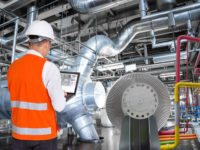An industrial business needs industrial solutions. This is a logical statement that is often not applied in practice. Many companies engaged in heavy industrial and other demanding, dangerous work opt for off-the-shelf consumer-grade technology for their workers, potentially slowing them down and even putting them at risk.
According to a 2020 study in the World Safety Journal, implementing high-grade technology can improve safety levels. We see this in the use of robotics and other automated equipment that takes the place of humans to perform dangerous tasks. But it also applies to computing. Upgrading from consumer to industrial-grade solutions can help protect workers and improve the performance of an entire organization.
Working smarter and safer
Rugged computing solutions can enhance and maintain workplace operations and safety in a number of ways. To begin with, they can help ensure efficiency, which is necessary to keep others safe. In industrial environments, dust, water and other foreign bodies can easily sabotage equipment. Ingress Protection (IP) is key to keeping them out, and comes in varying levels. Workers must also be able to read screens without difficulty whatever the conditions, including in bright sunlight. Poor visibility can impact decision-making, with major safety implications.
Computers at a port or on board a ship, for example, have to stand up to combustible gases or chemicals, heavy impact, and dramatic changes in temperature. Failure to do so can disrupt work, with the knock-on effect of damage to company reputation. In the worst cases it can cause accidents to happen, resulting in loss of property, injury and even death.
One of our clients, a maritime services company that helps large ships navigate in and out of the port, has seen rugged technology as a key investment to allow workers to be efficient while being safe. Since their work is subject to an ever-changing, sometimes harsh environment and mistakes can be disastrous, this investment has been a critical part of its digital transformation.
Timely communication makes all the difference
Employers need high-speed communication and real-time insights into an environment to determine potential hazards such as air quality and heat. Receiving information in a timely way can mean the difference between averting or presiding over a crisis. On-the-spot safety management through a mobile device helps an organization identify and ideally neutralize dangers as they arise.
Power that goes the distance
Another consideration that industrial-grade rugged solutions address is battery life and the danger of explosivity. A device is only useful if it has power, and in sectors such as oil and gas, workers are prohibited from recharging equipment because the consequences can be explosive – literally. Long-lasting battery life is therefore a basic requirement for peace of mind that rugged devices can deliver. Additionally, in an environment such as a rig or a mine, atmospheric corrosion, oil staining and chemical spillage is a constant threat to equipment.
To take the mining industry as an example, adopting rugged computers and tablets has helped miners work more productively and safely. Among other things, the workers rely on software for geological analysis on-site, and for the process to work, screens must deflect factors such as sunlight and condensation to remain clear at all times. Batteries must also support prolonged operation on a single charge. The key is being able to focus on the job at hand rather than the tools, secure in the knowledge that the technology will stand firm in the face of environmental challenges.
Intelligent software offers another layer of safety
Industrial-grade hardware is one thing, but software must also be designed to cater to the needs of workers in dangerous situations. Drivers are a prime example: devices can help them, but there are times when they must put them aside. A 2021 research from Virginia Tech Transportation Institute has shown that there are significant reductions in accidents following the deployment of safety technology. Whether operating a forklift in a storage facility or making a long-haul journey in a commercial vehicle, software that supports automatic screen blanking can reduce distractions, improve situational awareness and help drivers stay focused, promoting their own safety and that of others in the vicinity.
People are an enterprise’s most valuable asset and maintaining their health and safety should always be top priority. If an organization is serious about doing this, industrial-grade hardware and software technology solutions should be a non-negotiable investment.




